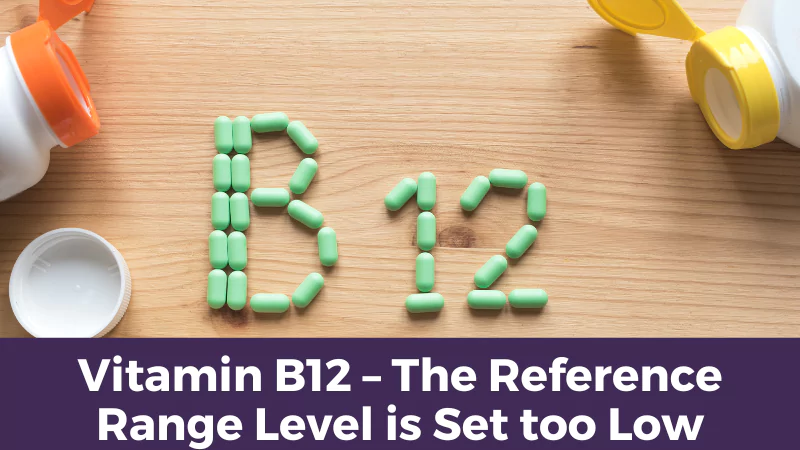As a statement made by one of the leaders in vitamin B12 field more than 10 years ago, Carmel’s idea of “cobalamin deficiency should not be diagnosed unless megaloblastic changes are found’ is still followed by many physicians and health authorities when accepting B12 deficiency diagnosis.1 But as time goes by, evidence and clinical cases showed that B12 deficiency symptoms can be seen even when B12 level in blood is within the reference range, as 200 – 900 pg/mL in the United States,2 and 135-650 pmol/L in Australia.3 In clinical practice, signs and symptoms of B12 deficiency start when plasma B12 levels are ‘normal’, and long historical studies showed that neurological symptoms of deficiency occur in patients without sign of anaemia. As a matter of fact, Japan raised its B12 reference range to 500 – 1300 Pmol in 1980s.

These phenomena raise some questions to us: Is the current reference range or normal lower limit of B12 set too low? What level should be set as the lower limit of B12 reference range? Could we use other clinical index to combine with B12 blood level to increase accuracy in diagnosis? The answers are definite and positive. It is well known that B12 supports two enzymes – methionine and methylmalonyl-CoA; when B12 level is low, two substrates of the enzymes will be built up – total homocysteine (tHcy) and methylmalonic acid (MMA). And thus these two substrates are called metabolic markers. It is found that these two markers started to increase even when B12 level was still above its lower limit of 148 pmol/L (200 pg/L), as such they are considered as more sensitive markers and may help for diagnosis of B12 deficiency.
In a study on 1000 community elderly, it was found that raised tHcy or MMA levels, as well as low holoTC (holotranscobalamin is the circulating form of B12 that is bound to transcobalamin) levels were related to cognitive deficit and reflexes impaired when B12 were within normal range. This indicates that not just lower levels of B12,but also levels above the lower limit, are risk levels for cognitive decline of B12 with symptoms. As a traditional concept, the mild metabolic abnormalities without clinical signs or symptoms are called subclinical cobalamin deficiency (SCCD), and it may progress to clinical symptomatic deficiency or remit completely without any signs.
Several large community studies indicate that, based on the measures of tHcy and MMA levels, the B12 inflection points fall between 200 and 500 pmol/L. For example, one study conducted by Vogiatzoglou and colleagues shows that, when tHcy and MMA reached their breakpoints of 334 and 393 pmol/L respectively as defined as B12 replete, the B12 levels were ≥ 400 pmol/L.8 Another study by Selhub and colleagues shows similar results and suggests that tHcy and MMA, as metabolic markers, may replace or augment B12 level in the diagnosis of B12 deficiency.5
In a clinical trial of determining the relationship between the treatment effect and tHcy levels on brain atrophy over 2 years, half of the participants were treated with B12, B6 and folic acid to lower their tHcy levels.9 Results showed that brain atrophy was slowed by 30% compared to placebo, tHcy was lower by 30%, and plasma B12 was raised from 330 to 672 pmol/L. The treatment effect was correlated with baseline tHcy levels, and even those patients with high baseline tHcy levels had cognitive decline and clinical status improvement. This confirms that tHcy can be used as a better marker in brain atrophy treatment, and B12 levels higher than the reference lower limit are connected with lower tHcy and brain atrophy signs.
Watch this webinar: Genes That Impact Your Folate, B12 and Methylation & How To Support Them
FREE Download What is MTHFR eBook
Based on these multiple clinical trials and studies, the traditional concept of SCCD may need to be modified, as patients with increased tHcy and MMA but within lower level of B12 of current reference range may have disease progression because the current reference range may have been set as too low.
So what does this mean for the patient and the practitioner? In our clinic, we test everyone who comes through our door for B12 levels. 80% of patients with MTHFR deficiency have levels below the Japanese level of 500 p/molL. Many present with typical signs of B12 deficiency including ataxia, numbness and tingling in fingers and toes, confusion, weakness and depression. As practitioners we have a duty of care. Vitamin B 12 deficiency is an easy thing to check for, its reasonably cost efficient and most Dr’s will happily check, so are we missing the symptoms? Is it all about the bloods?
No, it shouldn’t be – with diets the way they are, gastric banding surgery, hydrochloric acid inhibiting drugs like Somac and nexium being used widely that will inhibit B12 absorption and an ageing population we should be checking everyone of these people. Unless the reference ranges change, Dr’s and specialists will not consider that there might be a B12 deficiency. The Chief Naturopathic medical officer of the Canadian College of Naturopathic Medicine wrote in 2011 “serum levels of B12 not ‘classically deficient by current laboratory standards are associated with neuropsychiatric signs and symptoms” and “Most clinicians do not consider vitamin B12 important unless the serum level is deficient when indicated by laboratory reference ranges. Vitamin B12 therapy continues to be viewed by many mainstream minded clinicians as unexpected or unwarranted”.
Recently I referred a patient to their Dr to check for B12 deficiency. She was a young woman in her 20’s and was made to feel stupid for asking , however it was reluctantly done. She was called back immediately the next day with such a low B12 level they had to give her B12 injections every week for the next 8 weeks just to get levels back to normal.
Thus far, there is one thing that is clear: the current reference range is set as too low a level, and it may be raised to, conservatively, 500 pmol/L like they have in Japan.
Importantly, we need to be vigilant in checking B12 signs because its normal range, especially when it is within the lower level of normal range, may indicate deficiency progression. Clinicians should be re-evaluating the importance of lower than optimal serum vitamin B12 levels and consider the benefits of B12 treatment.
Bibliography
- Smith AD, Refsum H. Do we need to reconsider the desirable blood level of vitamin B12? Journal of Internal Medicine. 2012; 271(2): 179-82.
- US National Library of Medicine. http://www.nlm.nih.gov/medlineplus/ency/article/003705.htm
- Mirkazemi C, Peterson GM, Tenni PC, Jackson SL. Vitamin B12 deficiency in Australian residential aged care facilities. Journal of Nutrition, Health and Aging. 2012; 16(3): 277-80.
- Mitsuyama Y, Kogoh H. Serum and cerebrospinal fluid vitamin B12 levels in demented patients with CH3-B12 treatment–preliminary study. Japanese Journal of Psychiatry and Neurology. 1988; 42(1): 65-71.
- Selhub J, Jacques PF, Dallal G, Choumenkovitch S, Rogers G. The use of blood concentrations of vitamins and their respective functional indicators to define folate and vitamin B12 status. Food and Nutrition Bulletin. 2008; 29: S67–73.
- Carmel R. Biomarkers of cobalamin (vitamin B-12) status in the epidemiologic setting: a critical overview of context, applications, and performance characteristics of cobalamin, methylmalonic acid, and holotranscobalamin II. American Journal of Clinical Nutrition. 2011; 94: 348S–58S.
- Hin H, Clarke R, Sherliker P, Atoyebi W, Emmens K, Birks J, Schneede J, Ueland PM, Nexo E, Scott J, Molloy A, Donaghy M, Frost C, Evans JG. Clinical relevance of lowserum vitamin B12 concentrations in older people: the Banbury B12 study. Age and Ageing. 2006; 35: 412–22.
- Vogiatzoglou A, Oulhaj A, Smith AD, Nurk E, Drevon CA, Ueland PM, Vollset SE, Tell GS, Refsum H. Determinants of plasma methylmalonic acid in a large population: implications for assessment of vitamin B12 status. Clinical Chemistry. 2009; 55: 2198–206.
- de Jager CA, Oulhaj A, Jacoby R, Refsum H, Smith AD. Cognitive and clinical outcomes of homocysteine-lowering B-vitamin treatment in mild cognitive impairment: a randomized controlled trial. International Journal of Geriatric Psychiatry. 2012; 27(6): 592-600.
Watch this webinar: Genes That Impact Your Folate, B12 and Methylation & How To Support Them










